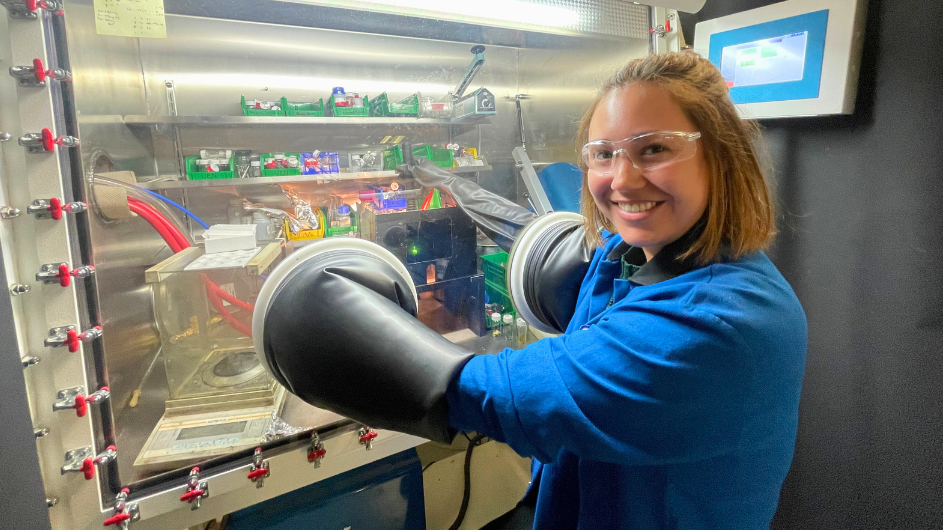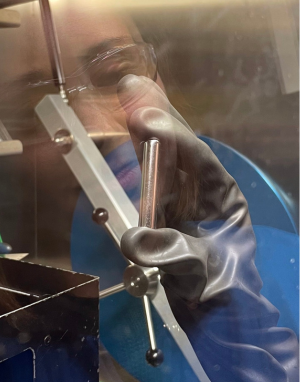Chemistry in a Vacuum
Victoria Posey talks about her PhD at Columbia and figuring out how to create new materials in the absence of air.

When chemists create new crystals, they never know exactly what they will get when they mix their ingredients and apply varying degrees of heat to them. The process gets a bit more complicated when the starting materials will react with oxygen, but air-free chemistry can be worth the extra effort.
Writing recently in Nature, scientists at Columbia described the first 2D heavy fermion—a material with electrons 1000 times heavier than usual that may possess several unique quantum properties. The crystal, composed of the air-sensitive elements cerium, iodine, and silicon (CeSiI), is the latest to come out of chemist Xavier Roy’s lab at Columbia and the first crystal they created entirely in an air-free, vacuum-sealed glove box.
Leading the effort to bring air-free chemistry to the Roy lab was chemistry PhD Victoria Posey. We spoke to her about the backstory of this unique new material and her time at Columbia.
Tell us the backstory to this new crystal.
We saw CeSil mentioned in a paper published in 1998 and thought it might have some interesting electronic properties, and it ended up being a two-dimensional heavy fermion, a class of material with extra-heavy electrons. But the synthesis was pretty hard. The starting materials—cerium, iodine, and silicon—have to be extremely pure, and they are extremely air-sensitive. We had to do all of the synthesis in a completely air-free glovebox, which wasn’t common practice in the lab.

When you successfully synthesize CeSil, you should get these shiny, copper-colored crystals, but there were a lot of busts along the way. Entirely in a glovebox, I had to mix the three powders and weld them shut in a tiny niobium ampule that wouldn’t melt at the temperatures needed for the reaction. It takes about a week to set things up, and then another week for the reaction itself, and you don’t know what you will get until you pry the ampule open.
It can still be painful to do air-free chemistry, but I spent a lot of time figuring out how to do the synthesis and subsequent measurements, which also have to be done air-free, more reliably and routinely.
How did you first get interested in chemistry?
I went into college undecided, but I always had a positive impression of chemistry. My dad is a food scientist and was always involved in my science fair projects. I had awesome teachers in high school who made chemistry super interactive and hands-on. I started working in chemistry labs in college, and my teachers and lab members suggested graduate school. It was never really the plan, but I kept having such great experiences in chemistry labs that I decided to apply to a few programs.
Why did you choose Columbia?
It’s such a collaborative environment—the Nature paper on CeSiI has over 30 co-authors on it. I knew going into my PhD program that I didn’t want to stay in academia, but I wanted to learn interpersonal skills, like how to work with people across fields and talk to others about technical topics in a non-technical way.
This project combined things like electronic properties, magnetism, and quantum physics, which, at first, were confusing. I’m a chemist; I didn’t know what a heavy fermion was when this started. But it was a great learning experience, and Columbia is a great environment for that. We work with almost all of the science departments, and I’ve had the opportunity to visit several national labs and research institutes as well.
Do you have a favorite national lab?
The National High Magnetic Field Laboratory known as the National MagLab, in Tallahassee. I’ve been so many times, and it’s really like home to me because I went to Florida State, which is right near the lab. The people there are so welcoming, and they really want you to enjoy your time there and get data that you can publish. They are just awesome people. I went for the last time in October, and I’ll miss it.
How was the original transition from Florida to New York?
There was some culture shock moving here. The first time it got cold, I had to go shopping with a labmate from California because we didn’t have sweaters. But now my family jokes that I’ll never move back to Florida because it’s too hot. I’ve been liking the cooler summers.
Do you think you’ll stay?
I’m inclined to leave the city. These kinds of life changes are a great way to experience something different—that’s how I motivated myself to move from Florida to New York. You don’t know what you are going to love until you try it out.
What’s the plan for finishing your final year and beyond?
I’d like to pivot to working in industry. In particular, I’d like to do something applicable to climate change—that could be battery synthesis or sustainable packing, but something chemistry-related in which I can make a difference.
In the meantime, there’s a lot left to do, and a lot that will not get finished. This project figuring out air-free chemistry has taken on a life of its own in the Roy lab, and I’m trying to pass off my knowledge so it can continue once I graduate in May.
Any advice to leave behind?
Grad school, in general, is going to be stressful and it will be hard on your mental health. Thankfully the world is becoming a better place to talk about mental health, but I think every single one of us grad students can struggle with it. Even though graduate school is worth it, you need to find outlets. I like to exercise and recently did my first half marathon. I’ve also been getting into more artistic things, like watercolor painting, pottery, and some baking.
